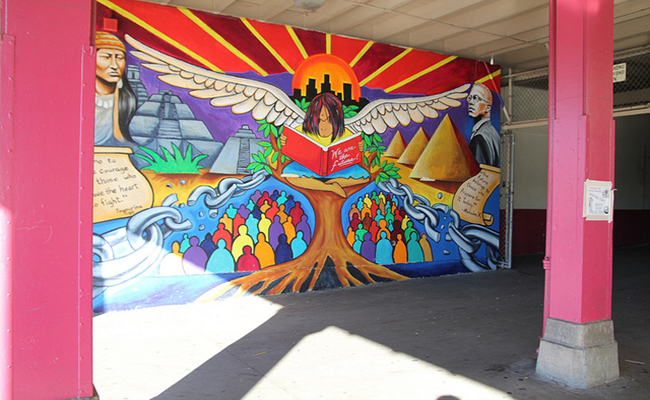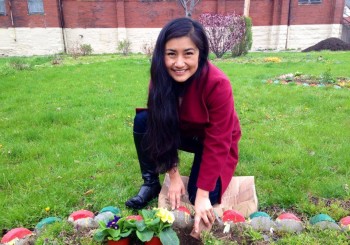Let me tell you a little something about South L.A.
A response to the L.A. Times article: “Soaring home prices spur a resurgence near USC.”

A South LA mural depicts the neighborhood’s mixing of cultures. | Foshay School 7th Grade Photo Project / Intersections
As I read the article mentioned above, I couldn’t help but picture “South Los Angeles” as a meaningless, desolate neighborhood infested with drugs, abandoned houses and cars, and weird and scary “ethnic” people. Thank goodness for gentrification, coming to save the day! (Note: sarcasm.)
Now, don’t get me wrong. I am not against diversified communities—racially, ethnically or socio-economically. In fact, I am completely in favor of mixed-income neighborhoods that promote the well-being of all residents, and enrich all of our lives, regardless of color, culture and economic status. I genuinely believe and embrace the richness of a multi-cultural, diverse world.
My issue is with gentrification. I am against the economics that underlie gentrification, and the segregation and further impoverishment that result from it. Moreover, I am against the image of desolation and decomposition that this article paints of my neighborhood.
So let me tell you a story about the real “South Los Angeles” you are referring to. About the thriving neighborhood — yes, thriving — that I and many others call home, and that you might be moving into.
I am of Mexican descent, born and raised in South Central. I lived there during the eighties and nineties, when it was a hard-core ‘hood facing serious criminal gang activity. I remember going to bed at the age of 10, waking up to drive-by shootings in the middle of the night, followed by the light of helicopters flashing through my bedroom window, and the sirens of cops on the streets chasing down the culprits.

Julieta Mendez gardening at the North American MOSAIC Convergence in Pittsburgh. | Julieta Mendez
I remember going to junior and senior high school, having to walk through metal detectors, and hearing rumors throughout the day that friends and classmates had been shot in gang fights. I remember not being allowed to go to quinceañera parties because you never knew what gang fight would ensue. And having to hire two body guards to watch over my quinceañera. Typical ‘hood life. You became almost apathetic to it. Almost. I hated living in South Central. I hated the horrible public education that I was receiving because I knew how limiting it was, and I hated feeling so unsafe.
Nevertheless, South Central was and still is home.
In the late nineties and early two-thousands, a transformation took place: the border between South Central L.A. and Koreatown became home to thousands of Oaxacan migrants that since then have redefined this neighborhood. (Oaxaca is a state in Southern Mexico and where my family is from.) From being a home to Bloods and Crips, the ‘hood became a home to the Zapotecos and Mixtecos — the indigenous peoples of Oaxaca.
Now, in 2014, as a working professional living in New York City, I love going home to South Central L.A. I love driving around my old streets and finding Oaxacan owned-businesses lined-up along Pico-Union and Western Avenue. I love seeing the Guelaguetza festival happening at Normandie Park. I love the smell of our food on the streets. I love going to a Oaxacan mass at the Santa Cecilia Church on Normandie Avenue. I love how our culture blends with the cultures of our Central American, Korean and African-American brothers and sisters. In short, I love how my people — the Oaxacan and South Central folk — have transformed and added so much richness (culturally, racially, ethnically, financially, and politically) to “the ‘hood,” and how we have all come to love this little piece of craziness known as South Central.
So I ask myself, as the wave of gentrification begins to slowly sweep through the ‘hood, what is going to happen to all this that has been built? South Los Angeles is not a meaningless, desolate neighborhood that has been slowly decomposing over the last 40 years. What is going to happen to all those people that have given so much, but lack the financial resources to own property? Where will they go? What will happen to their community and to their sense of identity?
I am not denying the benefits that come with this change: increased property values for homeowners, and better schools. But what about those that will be left by the wayside?
At the end of the day, we are all victims of the same phenomenon: an unjust increased cost of living. Maybe it’s time we all work together to fight for what is just.
Julieta Mendez, a native of South Central Los Angeles, currently lives in New York City, where she is pursuing her musical passions and working for the nonprofit sector. She hopes to one day return to L.A. to continue sowing the seeds planted long ago. You can follow her on Twitter at @missjulietisima.
Like us on Facebook, follow us on Twitter and sign up for the Newsletter to stay in the loop on news and views from South L.A.















Speak Your Mind